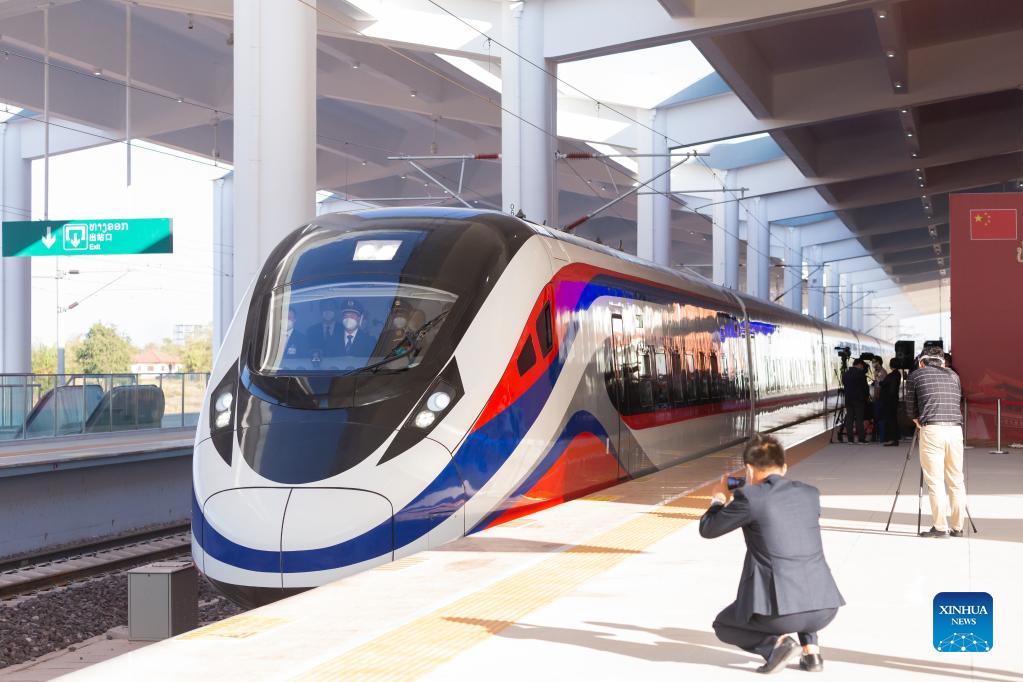
The Lane Xang EMU train of the China-Laos Railway departs from Vientiane Railway Station in Vientiane, Laos, Dec. 3, 2021. The China-Laos Railway was officially put into operation on Friday. (Photo by Kaikeo Saiyasane/Xinhua)
VIENTIANE, Dec. 3 (Xinhua) -- As the signature China-aided railway is declared operational on Friday, millions of Laos are celebrating as their dreams come true with opportunities created by the rail project that links the landlocked Asian country with China and the rest of the world.
The China-Laos Railway, with a length of 1,035 km, runs from the Lao capital Vientiane to Kunming, capital of southwest China's Yunnan Province on a 10-hour trip.
The cross-border electric passenger and freight railway, whose full-swing construction began in 2016, opens a new chapter for Laos, a country that once had virtually no rail infrastructure.
It is a docking project between the China-proposed Belt and Road Initiative and Laos' strategy to convert the landlocked country into a land-linked hub, leading the country to the massive markets of its neighboring countries, including China and other Southeast Asian nations.
GAME-CHANGER RAILROAD TO BOOST LAO ECONOMY
The Chinese-built railway becomes a game changer for the development of the only landlocked country in the Southeast Asian region. It will have a significant impact on Laos' economy, trade and tourism, and bolster the country's connectivity with the rest of the region.
The new railroad has a 422-km section within the Lao territory which runs from Boten in northern Laos to Vientiane with a maximum operating speed of 160 km per hour, and will take the geographically disadvantaged Laos to a new transportation milestone.
With the rail service in place, business operators in Laos will switch to the railway to export products, which is expected to cut transport costs across the country by 30-40 percent compared to travel by road, Valy Vetsaphong, vice president of the Lao National Chamber of Commerce and Industry, told Xinhua in a recent interview.
Valy, who is also an advisor to Lao Prime Minister Phankham Viphavanh, said the railway will lay a new foundation for the introduction of foreign investment and help Laos leverage its unique advantage to participate in regional and global industrial chains.
"The railway will result in the growth of many industries like tourism, trade and investment, especially in the processing industry, and it's going to help a lot for Laos' post-pandemic recovery," Valy said.
As an important part of the trans-Asian railway network, the China-Laos railway will connect Laos with more countries along the Belt and Road route linking both Asian and European continents.
Initially, at least 300,000 containers from Laos, mainly from the Thanaleng Dry Port, are expected to be transported via the railway to Europe through China each year, and shipments are estimated to rise further to between 1.2 and 1.8 million containers a year, according to Chanthone Sitthixay, chairman of Vientiane Logistics Park Co. Ltd.
MASS JOB OPPORTUNITIES
The railway, built by the Chinese engineering company China Railway Construction Group Co. Ltd., has created more than 110,000 jobs for Lao people during its construction. Around 2,000 km of roads and canals have been built along the railway in the country.
Since the railway's construction was launched, the project has drawn the interest of numerous local young talents who pursued their professional career on the railway, and many of them have grown into railway engineering masters.
Somechai Xayyavong, a 34-year-old man who came from the mountainous Xiengkhouang Province in Laos, joined the railway construction with PowerChina Sinohydro 15 in 2017.
"I learned more knowledge and skills to use higher-end equipment after coming to work on the railway, which employed more advanced technology," he told Xinhua, adding that he hoped to set up his own mapping company with expertise he has accumulated from his experience working with Chinese engineers.
Phonephimone Monechandy, a Lao girl who has a Chinese name "Peng Mengyu," was among over 100 Lao trainees interning at the China Railway No. 2 Engineering Group Vientiane by the end of October this year.
"In 2015, when I was studying at Guiyang Vocational and Technical College in Guizhou, China, I heard that the Laos-China Railway had held a groundbreaking ceremony, and then I decided to choose a major in railway operation and management," she recalled.
The railway passes by Peng Mengyu's hometown of Muangxay. After returning home, Peng signed up for the first training session of the Laos-China Railway Co., Ltd. (LCRC) and became a trainee in the train driver class.
"I am yearning for the Lao railway cause and its future, and have confidence that joining the railway team will surely help realize my value in life," Peng said.
ECOLOGICAL PROTECTION IN CONSTRUCTION
The natural tropical environment along the route remains a beautiful, verdant landscape sprawling with lush vegetation, just as it was before the construction of the Lao mega railway project five years ago.
The railway, which passes through 167 tunnels, is the first rail infrastructure built in Laos with the full application of Chinese management and technical standards.
Chinese contractors of the cross-border project have been doing their best to build a "green railway" in the country.
While building the sixth section of the railway, "every Chinese railway engineering company has set up leading teams in charge of environment protection, striving for construction progress and environment protection at the same time," said Xiao Qianwen, executive manager of the LCRC.
In the northernmost section, Chinese engineers and workers planted various kinds of vegetation such as winter jasmine and tea trees on roadbeds and tunnel slopes.
As the railway is winding through green mountains and across rivers in northern Laos, the tourist town of Vangvieng remains pristine and quiet, and the world cultural heritage of Luang Prabang remains intact with its scenic beauty appealing to tourists and nature lovers.
"Chinese standards are ecological standards," Xiao said. "A project like the China-Laos Railway must minimize disruption to the lives of people along the route." Enditem




